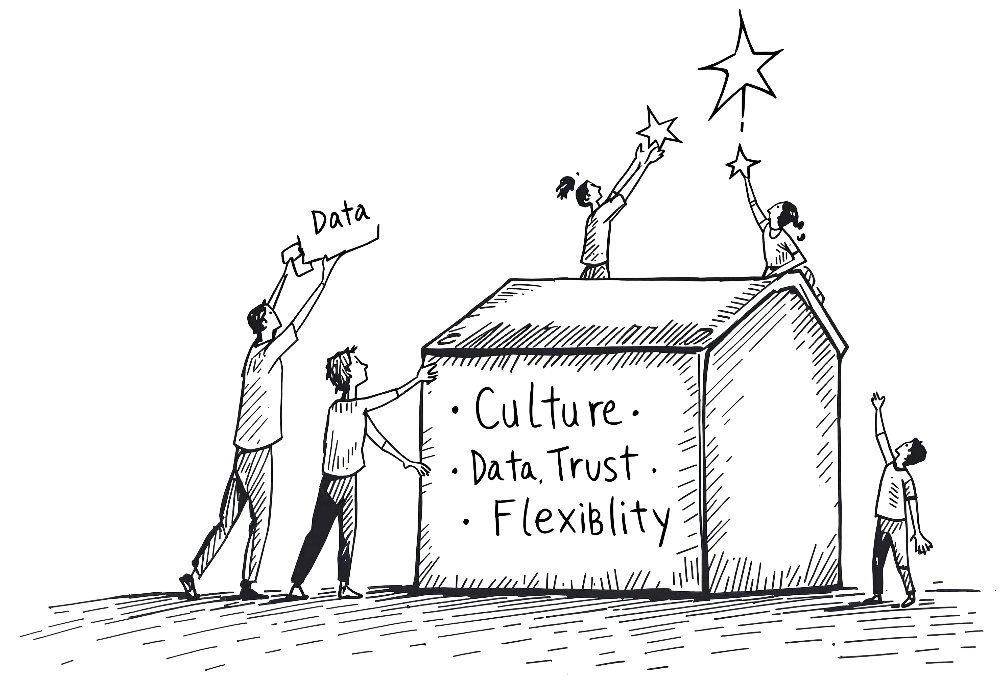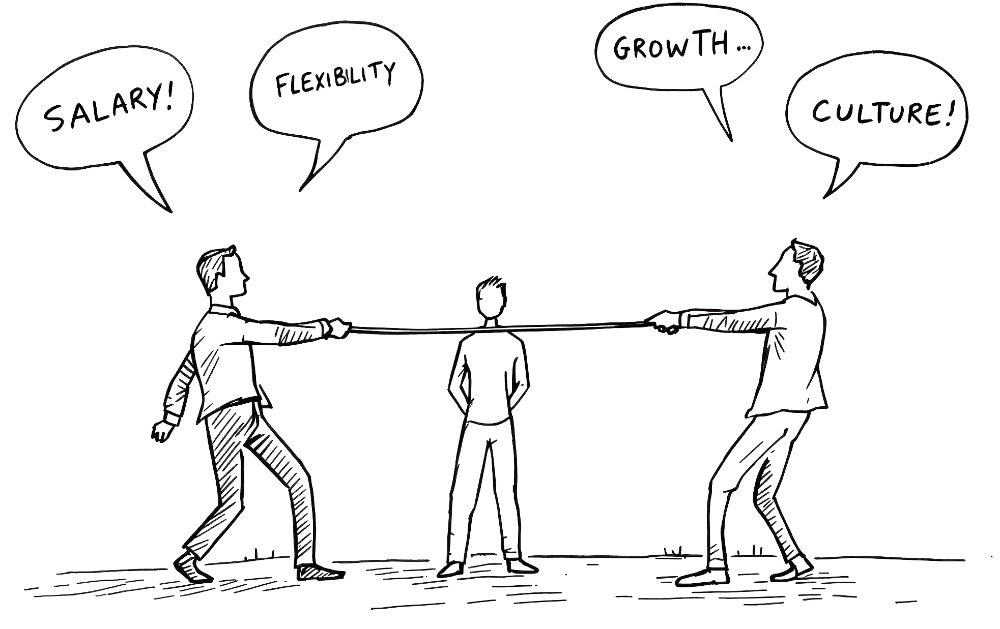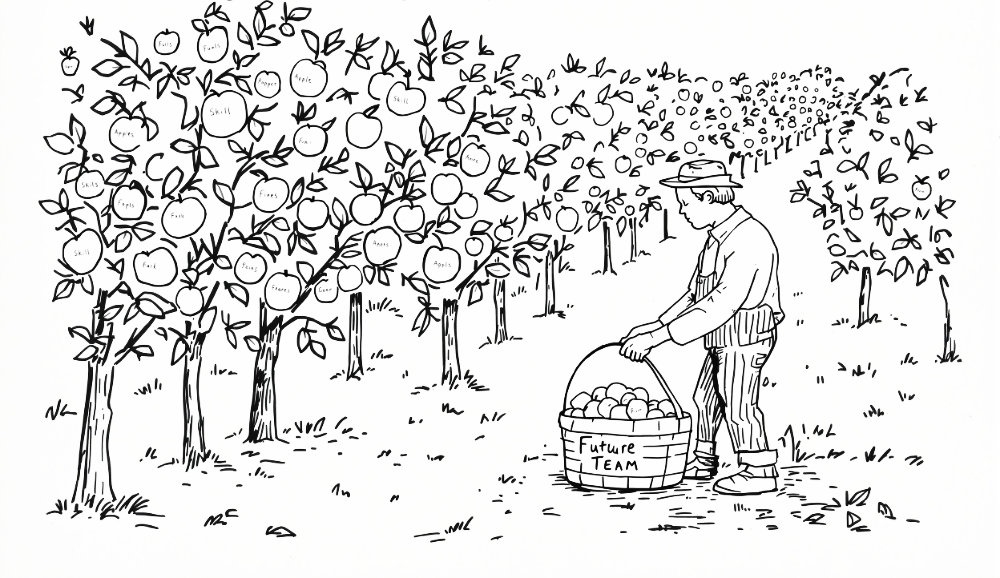I once learned something surprising from a watercolor painter I met in a small café. She said: “To capture the subtle hues of a sky just after sunrise, you must lay down the lightest washes first and let them guide the deeper tones.” It sounded trivial at the time, but lately, I’ve seen this wisdom apply to recruiting.
To attract top-tier talent in a market where everyone wants the same bright minds, you have to start with a clear, light-touch foundation—culture, story, purpose—before layering on the tangible rewards. Otherwise, you end up with a muddy picture.Yet the moment you try something fresh, you’ll find the room split into two perspectives. On one side, The Traditionalist insists that straightforward tactics—higher pay, well-known brand, fancy offices—will suffice. On the other side, The Innovator argues that top-tier talent now craves flexible work models, data-driven scouting, personalized career growth, and authentic voices. Let’s listen as they debate and, through their dialogue, uncover practical strategies you can apply.
The First Exchange: Old Promises vs. New Expectations
Traditionalist:
“Look, we’ve attracted top candidates for decades by offering a stable salary and a reputable logo on their resume. Why complicate matters? In a tight labor market, just up the compensation and advertise widely. They’ll come.”
Innovator:
“That’s the problem. Today’s top-tier professionals sift through offers like a seasoned traveler browsing flight options: price matters, but they’re also eyeing comfort, flexibility, even the quality of in-flight entertainment. It’s not enough to shout louder or pay more. They want meaning. They want to know you respect their time, their growth, their vision of life.”
“If you only rely on salary, you’ll hire mercenaries, not missionaries,” a lead recruiter once told me in confidence.
Reflecting on The Gap: Scenes from the Hiring Frontlines
Imagine two recruiters standing on opposite sides of a crowded fair. Each waves a sign. One sign reads: “Top Pay, Big Title, Corporate Stability.” The other reads: “Flexible Projects, Global Team, Innovative Tools.” Candidates pause, tilt their heads, and move closer to the second sign. Why? Because top talents often aren’t starved for money—they’re starved for purpose and growth.
But what’s purpose without proof?
Innovator:
“To offer authenticity, we must show our culture in action. No one believes well-rehearsed pitches anymore. They want to see teams collaborating, leaders mentoring, employees learning. They’ll ask about career paths. They’ll ask about whether the company invests in their professional future.”
Traditionalist:
“Sure, but doesn’t that slow things down? We need speed. The best candidates vanish in days.”
Innovator:
“Speed is essential, yes—but speed without substance is just noise. Use technology smartly. Tools like Machine Hiring can filter and identify strong candidates faster, but you still need a narrative worth believing.”
Building a Sustainable Talent Narrative
Question: How do you shape a narrative that stands out? By starting early. Think of your recruitment process as a journey rather than a transaction.
- Start with a well-defined value proposition: “Here, you’ll learn new technologies every quarter.”
- Highlight your support systems: “We pair each newcomer with a mentor who’s a domain expert.”
- Offer transparency: “Our promotion criteria are public. Our product roadmap is available to all employees.”
These moves attract high-performers who want to understand how their role connects to the bigger picture. If your narrative is shaky, it’s like painting with muddy water—nobody sees the bright colors.
Traditionalist:
“What if our industry is dull? A small B2B supplier hardly screams excitement.”
Innovator:
“Then find your angle. Even a B2B supplier can emphasize craftsmanship, the complexity of a niche market, or the opportunities to pioneer better processes. Sometimes, the allure is the chance to build something from scratch.”
Embracing Hybrid Models and Flexible Arrangements
A recruiter I knew once described the modern job market as a “menu of working conditions.” The best candidates browse for remote options, hybrid schemes, flexible hours. If you still demand everyone come in five days a week, you might lose an entire segment of talent who thrives best when given autonomy.
Innovator:
“Remember: top-tier people often know their own optimal working rhythms. Letting them choose can be a powerful lure.”
Traditionalist:
“But what about oversight and team cohesion? I fear losing control.”
Innovator:
“You’re not losing control, you’re trading blind authority for trust-based leadership. If you hire bright, self-driven minds, give them the space to shine. In a competitive market, trust itself becomes a selling point.”
Using Data to Identify Emerging Talent Pools
Some organizations cling to the same universities, the same job boards. This is old thinking. The most ambitious candidates appear in unexpected places—specialized online communities, niche hackathons, professional Slack groups.
Traditionalist:
“Isn’t that risky? We know our usual pipelines.”
Innovator:
“Riskier not to explore. With data analytics, you can pinpoint where your next star developer, strategist, or designer might be lurking. Maybe they’re active in an open-source project forum. Maybe they’re featured in a local industry podcast. Casting a wider net is essential now.”
Short Observation
In a world saturated with offers, being the first to spot a rare skill set is gold. A data-driven approach isn’t just a buzz phrase. It might mean using predictive analytics to see which candidates are likely to thrive under your leadership style or which new graduates show unusual potential based on their project portfolios rather than their GPA.
The Perks and Pitfalls of Early Outreach
Competition is often a tug-of-war for top candidates.
Innovator:
“We need to start conversations earlier. Connect before they are on the job market. Encourage employees to refer people they admire. Engage with talent communities. Send gentle signals that we’re open to future collaborations.”
Traditionalist:
“Why invest time in people who aren’t even looking yet?”
Innovator:
“Because when they do look, you’ll be top of mind. We’re building relationships, not just filling slots. In a fierce market, familiarity can tip the scales.”
“Nurture a talent pipeline as if you’re tending a garden. Don’t wait until you’re hungry to plant seeds,” said a hiring manager who managed to halve their time-to-hire by nurturing connections over months.
Demonstrate Your Culture Through Actions, Not Words
Traditionalist:
“Culture, culture, culture—that’s all I hear. Is it really that important?”
Innovator:
“Top performers scan for cultural cues. They watch how you treat them in the interview process. Delays, unclear communications, ghosting—these are red flags. If your internal culture values respect and transparency, let it shine through. Candidates read between the lines.”
Traditionalist:
“Fine, but how do we demonstrate that?”
Innovator:
“Encourage interviewers to be honest about challenges. Offer office tours, let candidates talk to future peers, share stories of real projects. Don’t just claim you support learning—mention that the company funded three team members to attend an industry conference last month.”
Preparing for Shifts in Demand
Markets change. Skills that are hot today might fade tomorrow. To consistently attract the best, you need to anticipate what’s next. Scenario planning allows you to think ahead: which emerging technologies might you need experts in next year? Which markets might your company enter soon?
Innovator:
“Without scenario planning, you’re always reacting. With it, you’re courting talent before the market even realizes those skills will be scarce.”
Traditionalist:
“That seems too abstract. We can’t predict the future.”
Innovator:
“True, but you can prepare multiple futures. If you suspect data scientists will be crucial soon, start identifying communities of data experts now. If you think sustainability consultants might matter next year, begin discreetly building relationships. The effort positions you a step ahead.”
Merging Human Judgment with Technology
Modern recruitment tools can help you navigate complexity—AI-driven applicant tracking systems can rank candidates, highlight unusual skill combinations, or even flag cultural fit indicators. But remember, these tools don’t replace human judgment. They amplify it. Humans set the criteria, interpret nuanced signals, and decide what truly matters in a candidate. Technology, like what Machine Hiring offers, can handle the grunt work of sifting through thousands of profiles, but it can’t infuse your company’s personality into the conversation.
When combined thoughtfully, human recruiters and data-driven tools become a powerful duo. The recruiter’s intuition and empathy work hand-in-hand with machine learning’s pattern recognition. This synergy frees up time so you can craft compelling messages, answer candidates’ questions sincerely, and present offers that feel personal rather than mass-produced.
The Interview as a Window
A candidate once joked to me, “Interviewing at some companies feels like speed dating with a grumpy librarian.” Awkward processes, vague questions, or boredom on the interviewer’s side signal a lack of respect. Candidates today demand a better experience. They know their worth.
Innovator:
“Make interviews engaging. Ask them about their dreams, let them solve a small puzzle relevant to your actual product, or invite them to a casual team chat. Offer feedback even if you reject them. Word spreads about candidate experience, and goodwill attracts talent.”
Traditionalist:
“Giving feedback to rejects? That takes time.”
Innovator:
“Yes, but it also shows integrity. Do you want top-tier talent or just anyone? The little extra effort sets you apart.”
Small Stories of Surprising Wins
A small startup once hired a brilliant UX designer by letting her spend a week as a ‘visiting collaborator.’ She got to know the team, saw how decisions were made, noticed the respect people had for each other. After that week, the designer was hooked. She turned down a bigger offer from a large company because she felt valued and understood. This narrative traveled through her network—attracting more curious, talented individuals who said, “I’ve heard you treat people well.”
These quiet stories act like magnets. You don’t need a huge employer brand if you have compelling, authentic stories.
Practical Moves
Shortlist of actions:
- Be transparent: Share your company’s vision, even the messy parts.
- Listen actively: After interviews, ask candidates how they felt about the process. Improve it.
- Offer growth paths: Show them exactly what they can become if they stay.
- Personalize communication: Address candidates by name, mention something unique about their background. Make them feel seen.
- Cultivate internal referrals: Happy employees bring in great people. Invest in employee engagement first.
The Clash Over Compensation
Traditionalist:
“What if after all this, we still lose top candidates to higher pay elsewhere?”
Innovator:
“Compensation matters. Be competitive. But if your entire strategy relies on throwing money, you’re building on a shaky foundation. Combine fair pay with intangible benefits—professional development, leadership opportunities, meaningful projects. That synergy often wins hearts.”
Traditionalist:
“Easy to say. What about those who won’t accept a penny less?”
Innovator:
“Not all top-tier talent is the same. Some prioritize money. Others prioritize a balanced life. Know your target persona and tailor accordingly. Some might accept slightly less pay if they see a clear path to innovation or mastery. Others might require top dollar, and that’s okay if their impact justifies it.”

Beyond the Interview: Onboarding as a Continuation
The process doesn’t end when a candidate signs the offer. The onboarding experience can confirm their choice or make them reconsider. Show them you meant every word you said. Assign a mentor, check in during their first weeks, clarify their goals. A well-executed onboarding cements trust.
Innovator:
“Think of onboarding as Act Two of your talent attraction strategy. If you fail there, Act One’s success might be wasted.”
Traditionalist:
“I never saw it that way, but it makes sense. If we promise growth and fail to deliver support early on, they’ll leave, and our reputation suffers.”
Candid Debriefs and Continuous Improvement
Set up periodic internal reviews of your recruitment strategy. Ask: Which channels brought the best hires? Did our referral program work? How did candidates rate their experience? Adjust swiftly. Top-tier talents move fast; your methods should adapt too.
Innovator:
“A marketplace that’s always shifting requires recruiters who never rest on past wins. Keep experimenting: maybe try virtual reality office tours, or host a technical challenge online. Add personal touches wherever possible.”
Traditionalist:
“That’s a lot of effort.”
Innovator:
“Yes, it is. But in a world where everyone is trying to snag the same people, extraordinary effort is what sets you apart. Just like an artist who experiments with new techniques to capture that elusive hue.”

Mentors, Role Models, and Internal Stars
Highlighting your internal heroes can be a decisive factor. Talented individuals often ask: “Who will I learn from?” If you have known experts, brilliant leaders, or well-regarded mentors, showcase them. Let candidates envision the relationships they’ll forge. Talent attracts talent—if they see inspirational figures within your ranks, they’ll be drawn in.
Innovator:
“Top-tier professionals choose workplaces where they can become better versions of themselves.”
Traditionalist:
“So, it’s not just about what we do for them, but who they’ll interact with?”
Innovator:
“Exactly. A market starved for great collaboration and mentorship finds value in the human ecosystem you present.”
Changing the Employer Mindset
For years, companies believed that if they built a big brand, talent would flock. Times have changed. The relationship between employers and employees is now more balanced. Top candidates act like consumers choosing among various products—your company is just one offering. Attracting them means respecting their choice, acknowledging their agency.
Innovator:
“In this scenario, honesty is more persuasive than hype. They know when they’re being sold a bill of goods. Respect their intelligence by telling them both the pros and the honest challenges.”
Traditionalist:
“Admitting flaws might scare them.”
Innovator:
“Or it might intrigue them. The best thrive on challenges, not glossy illusions. You might say, ‘We’re breaking into a new market and have no playbook. You’ll help write it.’ To the right person, that’s irresistible.”

From Theory to Ongoing Practice
No single technique guarantees success. It’s a blend of authenticity, flexibility, data, relationships, and respectful storytelling. Add scenario planning to stay ahead of changing demands. Use technology to filter noise and identify the gems. Offer candidates an experience that says, “We see you, we respect you, we want to grow with you.”
The Traditionalist might still grumble: “This sounds complicated.” The Innovator smiles: “It is, but so is capturing the subtle colors in a sunrise sky. With patience and skill, we can create something remarkable.”
Encouraging Stories and Mutual Learning
As markets tighten, the fight for top-tier talent becomes ever more nuanced. Each company finds its own mix of old-school credibility and new-school sincerity. We evolve by sharing stories—about what worked, what failed, and what surprised us.
If you have your own experiences—maybe a quirky initiative that landed a stellar candidate or a data-driven approach that surfaced hidden talent—share it. The collective wisdom of recruiters, leaders, and teams helps everyone grow.
Innovator:
“Let’s keep asking hard questions. How can we improve next quarter’s pipeline? Who’s the next audience we’ve overlooked? Stay curious.”
Traditionalist:
“Alright, I admit, there’s more to this than just paying well. Let’s try some of your ideas.”
Innovator:
“Good. When we paint with varied hues—culture, trust, data, authenticity—we attract those who appreciate the full spectrum.”
Ready to attract top-tier talent? Try Machine Hiring to find the best candidates faster.
Related Posts
Want to dive deeper into talent acquisition and HR strategy? Check out our comprehensive guide on how to align the HR strategy with the company’s long-term business objectives, where we explore creating an HR strategy that truly supports your company’s vision and goals.
For hands-on recruitment advice, our article on Effective Talent Acquisition Methods provides proven techniques for finding and attracting top candidates. You’ll also want to review Recruitment Metrics That Matter to understand the key performance indicators that can help optimize your hiring process.
Looking to leverage technology in your recruitment? Learn about the future of HR technology in AI Future of HR, and get practical guidance on selecting recruitment tools in our guide on how to choose the right AI ATS.


